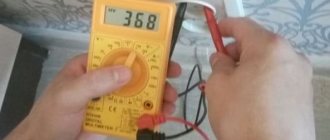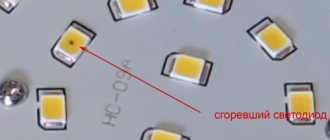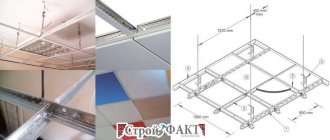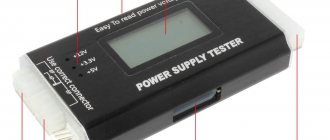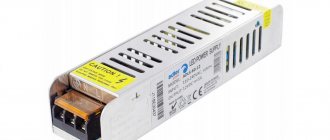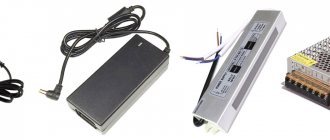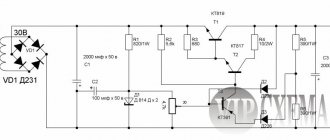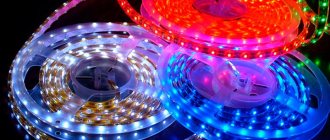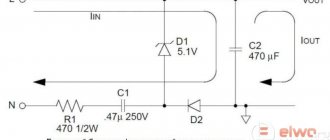Features of power supplies
For normal operation of LEDs, constant current and voltage must pass through them (the current-voltage characteristic of these light sources is nonlinear). When connected to the network, power supplies are required that reduce and rectify 220 V to the required value. Otherwise, with any jump, the electric current will sharply increase, the pn junction will overheat, and the LED chip will burn out.
The main requirement for a PSU (power supply unit) is the ability to smooth out surges that increase the voltage in the network during accidents, switching with powerful equipment, or lightning strikes.
Attention! You need to know that the service life of the unit depends not only on the time it has worked, but also on the shelf life. Electrolytic capacitors are built into this equipment, the performance of which is reduced due to evaporation of the electrolyte. The exception is the most expensive power supply models, in which electrolytic capacitors are replaced by more modern ceramic ones.
When purchasing, you need to pay attention to the power factor, which is denoted as λ or cos φ. The higher this indicator (from 0.85), the better the quality of the block and the more complex its design.
Nowadays you can buy LED lamps and luminaires with a device built into the body (most often the base) for stabilizing the electric current. But they are low-power, so they are able to work with the network without significant jumps. At the slightest deviation upward, they fail. To avoid such trouble, it is advisable to install a separate power supply in the LED lighting system.
Control unit characteristics
A power supply is an electrical structure whose main task is to convert 220V current into 12V or 24V depending on the required operating voltage. In most cases, switching power supplies are used to power LED lamps. Here resistors act as limiters. There is a common analogue of a power supply - a driver; its disadvantage is the absence of current limiters.
When choosing a power supply for LED light bulbs, you need to familiarize yourself with the characteristics that the device must have.
- Operating voltage of the lighting device.
- Total power of the LED strip.
- The need to protect the power supply housing from the harmful effects of the environment.
- Overall dimensions of the structure.
Operating voltage
The operating voltage of LED lamps, depending on the design modification, is 12V, 24V and sometimes 36V. The operating voltage of SPI controlled LED strips is only 5V. For smooth operation, the output voltage of the power supply must correspond to the specified parameters.
There are power supplies that allow you to manually adjust the output voltage; they are used to implement non-standard projects, as well as when you need to compensate for voltage drops on long wires.
There are also non-standard power supply modifications equipped with several channels. Each has a different output voltage. This can be very useful if you feed different tapes to one source.
Lighting fixture power
You must select a power supply according to power as follows: power = total power of LED lamps * short-circuit safety factor (it is equal to 15-30%). If you neglect the safety factor when choosing, the electrical device will work at the limit, its service life will be very limited.
To calculate the total power of an LED strip, you need to multiply each meter of its length by the power.
Dimensions
The dimensions of the case are of great importance. Powerful power supplies can be large, it will be almost impossible to hide them, and most of them are equipped with a built-in fan. If you need to connect a long section of tape, you can revise the connection diagram and use the option of operating several units that are smaller in size and power.
When choosing a place for installation, you need to consider: the higher the power of the device, the more it heats up, so it is important to provide enough space for the heat sink, otherwise it will overheat and quickly fail.
PFC in transformer characteristic
Power supply for LED strip 36W, 700mA, PFC
Sometimes on the power supply unit you can see the PFC marking, which in English means reactive power correction. This parameter indicates which circuit solution this model is designed on, which makes it possible to reduce power consumption.
Such modifications are characterized by a high power factor; they are high quality models with low starting current. Another advantage of such models is that with a large number of simultaneously used power supplies, there is no need to install and operate special starting machines.
The power supply is an electrical design that you cannot do without when installing LED lamps at home, at work, in the garage, etc.
Classification
The problem for the average consumer is related to the confusion of terminology. A power supply is a source designed to connect any radio-electronic equipment that produces a certain level of voltage and current.
Most LEDs require 4 V; when connected in series, the maximum number is 15 elements, which corresponds to a voltage of 60 V. The Russian network has 220 V, so the power supply must be included in the system.
It is incorrect to designate a power supply unit with the word “driver”, since this type of equipment only provides current stability (there are models that provide dimming). A driver can be called a device that provides power when connected to a 12 V or 24 V network. If the lighting device needs to be connected to 220 V, a power supply is required.
Historically, the device that provides the power parameters for an electrical appliance is called a ballast (ballast). When switching to LED lighting, the term was not changed. The same applies to the term “electronic transformer”. This device reduces voltage and increases frequencies; you can power a garland or a similar light source from it.
The power supply can be placed in the housing or separately from the lighting device, included in the delivery package or purchased separately.
By design, these devices are divided into 2 large groups:
- isolated;
- non-insulated.
An isolated power supply does not have a galvanic connection between input and output, which increases the level of safety during operation due to the low voltage level at the output. This type of power supply is made on the basis of a transformer, the primary winding of which is connected to the network. An LED lamp or strip is connected to the secondary winding. Isolated models are relatively expensive, but they smooth out voltage surges and impulses well, which is especially important for the Russian power grid.
LED Power Supply
To repair the power supply of an LED lamp, you need to understand the operating principle of such a system element.
The power source of such a lighting device must meet a number of requirements. The main ones are the following:
- energy efficiency;
- reliability;
- electromagnetic compatibility;
- safety.
Only by providing the LEDs with a power source with the listed qualities can one achieve proper operation of the device and extend its service life.
It is worth noting that the service life of the presented lighting devices is at least 50 thousand hours. Accordingly, the power supply should work for at least as long. It must be remembered that the main reason why LED lamps are replacing all other types of lighting devices is energy-saving technologies. Therefore, the power supply must also have high efficiency. Otherwise, due to the power supply, the energy savings will be negligible.
It is also worth noting that the presented part is the only source of electromagnetic interference. Therefore, the compatibility of the LED lamp with the electrical network depends on the power supply.
The only element in the presented lighting device to which voltage is supplied from the household network is the power supply for LED lamps. 220V in this element of the system is transformed, decreasing to 12 V at the output. For this reason, the electrical safety of the device depends entirely on this device.
In addition, the power supply affects the lighting characteristics of the lamp and how much current will flow through the LED. If it pulsates, then the light output will be of poor quality and have a bad effect on vision.
Major PSU manufacturers
Theoretically, the power supply should be supplied with the lighting fixture. In practice, this does not always happen. If the power supply is not included in the package, you need to buy products from companies specializing in these products (Trion, Argos-Electron, Meanwell, etc.).
on the market since 2012, ranks third in the country in terms of production volume, 1.5 million modules sold, failure rate only 0.2%. The production of power supplies for LED lighting devices in this company is one of the main activities. Finished products are tested and tested using methods developed by in-house engineers. Quality is controlled at all stages of production.
Argos-Electron from St. Petersburg has been on the market since 2008. This is one of the leading manufacturers of components for lighting systems with LED light sources. Argos-Electron produces drivers for industrial, street and office lamps, lighting devices for housing and communal services. Finished products are tested with LED simulators, in heating cabinets and thermal chambers.
Meanwell Founded in 1982, supplies switching power supplies. Offers approximately 5 thousand standard models for LED lighting automation. Products are subject to strict control at all stages of production, starting from project development and selection of components.
The Helvar brand offers isolated and non-isolated switching power supplies, controlled and uncontrolled drivers. A wide range allows you to create simple local and large-scale LED lighting systems.
The Vossloh-Schwabe company (divisions of the Panasonic Group) produces power supplies, drivers, control systems for lamps and strips installed indoors and outdoors. The equipment is supplied complete. The production uses modern equipment and advanced technologies.
Connection procedure
In addition to purchasing, you need to know how to connect the power supply correctly. First of all, you need to calculate the required power and draw conclusions whether your unit is suitable for the desired amount of 12V LED strip. To connect LEDs, you need to follow some rules:
- To connect two or more tapes to the power supply, parallelism must be maintained.
- It is not permissible to change the polarity of the wires on the LED strip and on the power supply.
- If two strips are connected in parallel, you need to run wires with a cross-section of 1.5 mm² to the second one. A large cross-section will result in a loss of voltage.
- When installing two light sources in parallel with two power sources, to extend the second element, it is permissible to use a wire with a cross-section of 0.75 mm².
External power supplies not included in delivery
When buying an external power supply, you need to know that it will achieve maximum efficiency at 80% of the rated power. To obtain the optimal value, it is necessary to multiply the power of the LED light source by 1.2-1.15 (safety factor).
If a unit is purchased with the expectation that additional light sources will be connected to it in the future, then the power of the lamps that will be connected immediately should be 1.2 times less than the minimum load of the power supply unit. Otherwise, when turned on, the idle speed protection will work.
It is advisable to connect the external unit even to those lighting fixtures that have built-in drivers. The degree of protection of the power supply is also important. If the lamp is installed outdoors or in a room with high humidity levels, protection level IP65 will be required. You should not overpay if the lighting system is installed in a heated residential area.
Selecting a Power Option
If the lamps illuminate a room that does not require special quality of light, then it is quite possible to use transformer or pulse type power supplies. In this case, light pulsations due to voltage surges will not be particularly noticeable.
In cases where a high quality light stream is required, and also if this lamp consumes a lot of power, it is recommended to use a driver.
The choice of power supply is also influenced by the location of the lamp. In particular, this affects the degree of protection. In a residential area it should be lower, but in an aggressive environment with dust and moisture the requirements will be higher.
Assemble with your own hands
With your own hands you can make not only Ice lamp, but also a simple power supply for it (not switching). The circuit can be transformer or transformerless (the second is simpler). Requires a diode bridge, resistors and capacitors.
The first to be installed is a capacitor that limits the alternating current. Properly selected capacitance guarantees that the required current will be supplied to the LEDs. The voltage of this element is from 300 V.
Important! An electrolytic capacitor is not suitable for a power supply.
A shunt resistor with a resistance sufficient to discharge the capacitor when the lamp is turned off is connected in parallel. Power doesn't matter much.
The next element is a diode bridge, which converts alternating current into direct current. You can buy an assembly or solder several diodes with characteristics suitable for the circuit. The current must be greater than that flowing through the lamp, the reverse voltage is from 300 V.
After the bridge, the electric current is constant, but spasmodic. The situation can be improved by a smoothing capacitor of 300-400 V with a capacity of 10 microfarads. A resistor is connected to it for shunting.
This power supply is suitable for serial connection of up to 75 bright LEDs with a voltage of 3.5 V and a current of 20 mA. The brightness of the glow changes with the capacitance of the first capacitor.
This scheme is not safe enough, since if moisture gets into the lamp, it can cause an electric shock.
If you use a transformer, its power should be one and a half times the power of the lamp. The output should be 12-20 V. After the transformer, a filter capacitance and a stabilizer based on the 7812 microcircuit are turned on, providing an output current of up to 1.5 A.
Transformer block
Today it is quite rare to see the use of a transformer power supply. The scheme of their assembly and operation is quite simple and understandable.
The most important element here is definitely the transformer. At home, it converts 220V voltage into 12 or 24V. That is, there is a direct conversion of one voltage to another.
The network frequency is the usual 50 Hertz.
Next behind it is a rectifier. It rectifies the alternating voltage sinusoid and produces a “constant” voltage at the output. That is, 12V supplied to the consumer is already a constant voltage of 12V, and not alternating.
This scheme has 3 main advantages:
- its simplicity
- simplicity of design
- relative reliability
However, there are also disadvantages here that made the developers think and come up with something more modern.
- firstly, it is heavy and has decent dimensions
- as a consequence of the first drawback - a large consumption of metal for assembling the entire structure
- Well, the whole thing is worsened by low cosine phi and low efficiency
This is why switching power supplies were invented. There is a slightly different operating principle here.
